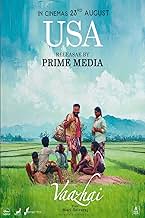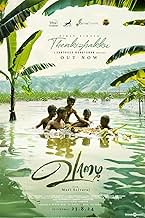A twelve-year-old boy, Sivanandhan, his mother, sister, and friend navigate life's challenges, where a plantain tree, Vaazhai, becomes a central presence.A twelve-year-old boy, Sivanandhan, his mother, sister, and friend navigate life's challenges, where a plantain tree, Vaazhai, becomes a central presence.A twelve-year-old boy, Sivanandhan, his mother, sister, and friend navigate life's challenges, where a plantain tree, Vaazhai, becomes a central presence.
- Director
- Writer
- All cast & crew
- Production, box office & more at IMDbPro
Featured reviews
10v-raj
A heart-rending film directed by a master film maker.
Starting with a child's infatuation with a teacher it gradually takes on more serious issues. It is woven beautifully with one serious issue after another.
Based on a true story It is set in the end of last century.
The child actors have done exceedingly well. The cinematography is stunning The adults have played their parts perfectly. The old Illayaraja songs add magic to the storytelling.
His earlier films, Paraiyerum Perumal had set a high level. Karnan was just as good.
This film is without doubt his Magnum Opus.
Tamil cinema is in safe hands.
Starting with a child's infatuation with a teacher it gradually takes on more serious issues. It is woven beautifully with one serious issue after another.
Based on a true story It is set in the end of last century.
The child actors have done exceedingly well. The cinematography is stunning The adults have played their parts perfectly. The old Illayaraja songs add magic to the storytelling.
His earlier films, Paraiyerum Perumal had set a high level. Karnan was just as good.
This film is without doubt his Magnum Opus.
Tamil cinema is in safe hands.
Vaazhai is more than just a film and those who have experienced it knows it leaves a mark - a film that is psychologically draining yet ultimately heartwarming coming-of-age journey that evokes smiles but with a heavy heart. It is a remarkable film from threads of real life events from director Mari Selvaraj's own life.
It follows the arduous journey of young Sivanaindhan, living with his mother and sister in the idyllic yet challenging village of Puliyankulam near Tirunelveli. He and his best friend Sekar navigate the treacherous terrain of poverty, a relentless cycle of labor mirroring the hardships. Sivanaindhan has a morbid wish, might sound messed up but he hopes that someone in the village passes away daily so he can avoid the laborious task of lugging. The banter between both about Kamal Haasan and Rajinikanth is sure to elicit laughter from audiences and this adds a layer of humor to the film.
However, amidst the harsh realities, a delicate beauty unfolds. Despite the weight of existence, Sivanaindhan remains steadfast in his studies, finding solace in the gentle gaze of teacher Poongkodi.
Furthermore, Sivanaindhan's obsession with Poongkoodi reaches new heights as he not only sniffs her handkerchief and hums songs named after her but also accompanies her on her daily errands, such as visiting the rice mill. This is like a beacon of hope for the young Sivanaindhan who doesn't want to miss school amidst the tempest of life that demands he carry banana plantains to repay the debt of his late Father. The film's emotional climax and surreal imagery are hallmarks of Mari Selvaraj's distinctive style. The director skillfully employs a raw sequence involving paper cuttings to reveal the true incident.
Mari Selvaraj, a master storyteller, paints a vivid portrait of childhood with a fine balance between nature's elements and the village's intricate caste dynamics. The cinematography captures the beauty and the brutality of rural life with equal poignancy. Additionally, Mari Selvaraj's approach to the film's intermission was particularly noteworthy. Instead of relying on the conventional template, he opted for a more retro-inspired cinematic technique, utilizing on-screen text to echo Sivanaindhan's internal turmoil and his vow to his mother.
For some, the boy's daily life might seem mundane, and the village life, with its fights and caste divides, might appear like not an everyday affair to city dwellers. But I guarantee you that Vaazhai provides a unique perspective, showcasing the complexities of rural life that often go unnoticed as it delves deeper revealing another side of Sivanendhan's inner world. His coming-of-age experiences, a delicate blend of joy and sorrow, which will be rewarding for those seeking a thought-provoking and emotionally resonant cinematic experience.
It follows the arduous journey of young Sivanaindhan, living with his mother and sister in the idyllic yet challenging village of Puliyankulam near Tirunelveli. He and his best friend Sekar navigate the treacherous terrain of poverty, a relentless cycle of labor mirroring the hardships. Sivanaindhan has a morbid wish, might sound messed up but he hopes that someone in the village passes away daily so he can avoid the laborious task of lugging. The banter between both about Kamal Haasan and Rajinikanth is sure to elicit laughter from audiences and this adds a layer of humor to the film.
However, amidst the harsh realities, a delicate beauty unfolds. Despite the weight of existence, Sivanaindhan remains steadfast in his studies, finding solace in the gentle gaze of teacher Poongkodi.
Furthermore, Sivanaindhan's obsession with Poongkoodi reaches new heights as he not only sniffs her handkerchief and hums songs named after her but also accompanies her on her daily errands, such as visiting the rice mill. This is like a beacon of hope for the young Sivanaindhan who doesn't want to miss school amidst the tempest of life that demands he carry banana plantains to repay the debt of his late Father. The film's emotional climax and surreal imagery are hallmarks of Mari Selvaraj's distinctive style. The director skillfully employs a raw sequence involving paper cuttings to reveal the true incident.
Mari Selvaraj, a master storyteller, paints a vivid portrait of childhood with a fine balance between nature's elements and the village's intricate caste dynamics. The cinematography captures the beauty and the brutality of rural life with equal poignancy. Additionally, Mari Selvaraj's approach to the film's intermission was particularly noteworthy. Instead of relying on the conventional template, he opted for a more retro-inspired cinematic technique, utilizing on-screen text to echo Sivanaindhan's internal turmoil and his vow to his mother.
For some, the boy's daily life might seem mundane, and the village life, with its fights and caste divides, might appear like not an everyday affair to city dwellers. But I guarantee you that Vaazhai provides a unique perspective, showcasing the complexities of rural life that often go unnoticed as it delves deeper revealing another side of Sivanendhan's inner world. His coming-of-age experiences, a delicate blend of joy and sorrow, which will be rewarding for those seeking a thought-provoking and emotionally resonant cinematic experience.
"**Vazhai**" is a film that truly left a deep impact on me. It cannot be categorized as a movie meant for just one community; it is a film for all Tamilians. The movie speaks about the exploitation of labor, about love, and the pains of life. It is a must-watch for the younger generation as well. The cinematographer beautifully captures the essence of our land, from a mother cow that has lost its calf, to the millipedes that appear during the rainy season, and even the Odakkan. I could go on and on about this film. This is a quality life-drama film in Tamil cinema. Must watch in theatres, at least send this to the Oscar.
Very Good movie based on real events .I can say that the best movie from Mari Selvaraj. No politics like his earlier movies. Only real story with some movie element to make you engaged .The cinematography and music is top notch If you are somewhat familiar with the life in villages, you will definitely love this movie. If you lived your entire life in cities like Chennai you may not connect with this movie. No powerful mainstream hero, duet songs and typical fight scene. You will love the portrayal of lifestyle in southern districts in Tamilnadu in 1980s. The inclusion of movie songs from that era is beautiful. The only concern to me was overloaded emotion.
After watching Karnan, the main issue I felt with its screenplay was that it lacked any relief moments between the heavy or traumatic scenes. Nearly every scene carried some form of trauma. In Mamannan, while there weren't as many traumatic moments, and there were some pauses between heavy scenes, there still weren't enough contrasting or lighter moments.
However, in Vaazhai, these issues are not present. The screenplay includes some well-placed relief moments that allow the audience to slow down and regain energy before the trauma hits again.
After seeing Director Bala become emotional after watching this movie, I prepared myself for an intense emotional ride. Perhaps because I was expecting something overwhelming, I found that the movie wasn't as distressing or saddening as I anticipated. The film primarily addresses capitalist ideologies, and it is well-made, brilliantly portrayed, and effectively showcased.
However, in Vaazhai, these issues are not present. The screenplay includes some well-placed relief moments that allow the audience to slow down and regain energy before the trauma hits again.
After seeing Director Bala become emotional after watching this movie, I prepared myself for an intense emotional ride. Perhaps because I was expecting something overwhelming, I found that the movie wasn't as distressing or saddening as I anticipated. The film primarily addresses capitalist ideologies, and it is well-made, brilliantly portrayed, and effectively showcased.
Did you know
- TriviaBased on the real life events happened to the Director.
- How long is Vaazhai?Powered by Alexa
Details
- Release date
- Country of origin
- Language
- Also known as
- Fruit of labour
- Production company
- See more company credits at IMDbPro
Box office
- Gross worldwide
- $611,095
- Runtime2 hours 14 minutes
- Color
- Sound mix
- Aspect ratio
- 2.35 : 1
Contribute to this page
Suggest an edit or add missing content


![Watch Trailer [OV]](https://m.media-amazon.com/images/M/MV5BZWZiYzY4ODktOGM0YS00Y2ExLTlmMGItMzNmYjM3ZTIxMDlmXkEyXkFqcGdeQXRyYW5zY29kZS13b3JrZmxvdw@@._V1_QL75_UX500_CR0)





















